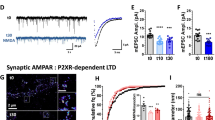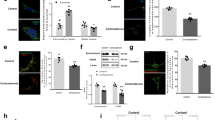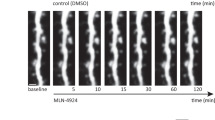Abstract
Intrinsic antioxidant defenses are important for neuronal longevity. We found that in rat neurons, synaptic activity, acting via NMDA receptor (NMDAR) signaling, boosted antioxidant defenses by making changes to the thioredoxin-peroxiredoxin (Prx) system. Synaptic activity enhanced thioredoxin activity, facilitated the reduction of overoxidized Prxs and promoted resistance to oxidative stress. Resistance was mediated by coordinated transcriptional changes; synaptic NMDAR activity inactivated a previously unknown Forkhead box O target gene, the thioredoxin inhibitor Txnip. Conversely, NMDAR blockade upregulated Txnip in vivo and in vitro, where it bound thioredoxin and promoted vulnerability to oxidative damage. Synaptic activity also upregulated the Prx reactivating genes Sesn2 (sestrin 2) and Srxn1 (sulfiredoxin), via C/EBPβ and AP-1, respectively. Mimicking these expression changes was sufficient to strengthen antioxidant defenses. Trans-synaptic stimulation of synaptic NMDARs was crucial for boosting antioxidant defenses; chronic bath activation of all (synaptic and extrasynaptic) NMDARs induced no antioxidative effects. Thus, synaptic NMDAR activity may influence the progression of pathological processes associated with oxidative damage.
This is a preview of subscription content, access via your institution
Access options
Subscribe to this journal
Receive 12 print issues and online access
$209.00 per year
only $17.42 per issue
Buy this article
- Purchase on Springer Link
- Instant access to full article PDF
Prices may be subject to local taxes which are calculated during checkout









Similar content being viewed by others
References
Mariani, E., Polidori, M.C., Cherubini, A. & Mecocci, P. Oxidative stress in brain aging, neurodegenerative and vascular diseases: an overview. J. Chromatogr. B Analyt. Technol. Biomed. Life Sci. 827, 65–75 (2005).
Halliwell, B. Oxidative stress and neurodegeneration: where are we now? J. Neurochem. 97, 1634–1658 (2006).
Yoshida, T., Nakamura, H., Masutani, H. & Yodoi, J. The involvement of thioredoxin and thioredoxin binding protein-2 on cellular proliferation and aging process. Ann. NY Acad. Sci. 1055, 1–12 (2005).
Hattori, F., Murayama, N., Noshita, T. & Oikawa, S. Mitochondrial peroxiredoxin-3 protects hippocampal neurons from excitotoxic injury in vivo. J. Neurochem. 86, 860–868 (2003).
Sanchez-Font, M.F. et al. Peroxiredoxin 2 (PRDX2), an antioxidant enzyme, is under-expressed in Down syndrome fetal brains. Cell. Mol. Life Sci. 60, 1513–1523 (2003).
Qu, D. et al. Role of Cdk5-mediated phosphorylation of Prx2 in MPTP toxicity and Parkinson's disease. Neuron 55, 37–52 (2007).
Wood, Z.A., Schroder, E., Robin Harris, J. & Poole, L.B. Structure, mechanism and regulation of peroxiredoxins. Trends Biochem. Sci. 28, 32–40 (2003).
Rhee, S.G., Jeong, W., Chang, T.S. & Woo, H.A. Sulfiredoxin, the cysteine sulfinic acid reductase specific to 2-Cys peroxiredoxin: its discovery, mechanism of action, and biological significance. Kidney Int. Suppl. 72, S3–S8 (2007).
Budanov, A.V., Sablina, A.A., Feinstein, E., Koonin, E.V. & Chumakov, P.M. Regeneration of peroxiredoxins by p53-regulated sestrins, homologs of bacterial AhpD. Science 304, 596–600 (2004).
Mennerick, S. & Zorumski, C.F. Neural activity and survival in the developing nervous system. Mol. Neurobiol. 22, 41–54 (2000).
Olney, J.W. et al. Drug-induced apoptotic neurodegeneration in the developing brain. Brain Pathol. 12, 488–498 (2002).
Papadia, S. & Hardingham, G.E. The dichotomy of NMDA receptor signaling. Neuroscientist. 13, 572–579 (2007).
Ikonomidou, C. et al. Blockade of NMDA receptors and apoptotic neurodegeneration in the developing brain. Science 283, 70–74 (1999).
Tashiro, A., Sandler, V.M., Toni, N., Zhao, C. & Gage, F.H. NMDA receptor–mediated, cell-specific integration of new neurons in adult dentate gyrus. Nature 442, 929–933 (2006).
Ikonomidou, C., Stefovska, V. & Turski, L. Neuronal death enhanced by N-methyl-D-aspartate antagonists. Proc. Natl. Acad. Sci. USA 97, 12885–12890 (2000).
Nakayama, K., Kiyosue, K. & Taguchi, T. Diminished neuronal activity increases neuron-neuron connectivity underlying silent synapse formation and the rapid conversion of silent to functional synapses. J. Neurosci. 25, 4040–4051 (2005).
Hardingham, G.E., Fukunaga, Y. & Bading, H. Extrasynaptic NMDARs oppose synaptic NMDARs by triggering CREB shut-off and cell death pathways. Nat. Neurosci. 5, 405–414 (2002).
Papadia, S., Stevenson, P., Hardingham, N.R., Bading, H. & Hardingham, G.E. Nuclear Ca2+ and the cAMP response element-binding protein family mediate a late phase of activity-dependent neuroprotection. J. Neurosci. 25, 4279–4287 (2005).
Jin, M.H. et al. Characterization of neural cell types expressing peroxiredoxins in mouse brain. Neurosci. Lett. 381, 252–257 (2005).
Schulze, P.C. et al. Hyperglycemia promotes oxidative stress through inhibition of thioredoxin function by thioredoxin-interacting protein. J. Biol. Chem. 279, 30369–30374 (2004).
Adams, S.M., de Rivero Vaccari, J.C. & Corriveau, R.A. Pronounced cell death in the absence of NMDA receptors in the developing somatosensory thalamus. J. Neurosci. 24, 9441–9450 (2004).
Chang, T.S. et al. Characterization of mammalian sulfiredoxin and its reactivation of hyperoxidized peroxiredoxin through reduction of cysteine sulfinic acid in the active site to cysteine. J. Biol. Chem. 279, 50994–51001 (2004).
Woo, H.A. et al. Reduction of cysteine sulfinic acid by sulfiredoxin is specific to 2-cys peroxiredoxins. J. Biol. Chem. 280, 3125–3128 (2005).
Brunet, A. et al. Akt promotes cell survival by phosphorylating and inhibiting a Forkhead transcription factor. Cell 96, 857–868 (1999).
Nakae, J., Barr, V. & Accili, D. Differential regulation of gene expression by insulin and IGF-1 receptors correlates with phosphorylation of a single amino acid residue in the forkhead transcription factor FKHR. EMBO J. 19, 989–996 (2000).
Olive, M., Williams, S.C., Dezan, C., Johnson, P.F. & Vinson, C. Design of a C/EBP-specific, dominant-negative bZIP protein with both inhibitory and gain-of-function properties. J. Biol. Chem. 271, 2040–2047 (1996).
Niehof, M., Manns, M.P. & Trautwein, C. CREB controls LAP/C/EBPβ transcription. Mol. Cell. Biol. 17, 3600–3613 (1997).
Zhang, S.J. et al. Decoding NMDA receptor signaling: identification of genomic programs specifying neuronal survival and death. Neuron 53, 549–562 (2007).
Soriano, F.X. et al. Preconditioning doses of NMDA promote neuroprotection by enhancing neuronal excitability. J. Neurosci. 26, 4509–4518 (2006).
Steigerwald, F. et al. C-terminal truncation of NR2A subunits impairs synaptic, but not extrasynaptic localization of NMDA receptors. J. Neurosci. 20, 4573–4581 (2000).
Liu, Y. et al. NMDA receptor subunits have differential roles in mediating excitotoxic neuronal death both in vitro and in vivo. J. Neurosci. 27, 2846–2857 (2007).
Tovar, K.R. & Westbrook, G.L. The incorporation of NMDA receptors with a distinct subunit composition at nascent hippocampal synapses in vitro. J. Neurosci. 19, 4180–4188 (1999).
Chen, H.S. & Lipton, S.A. The chemical biology of clinically tolerated NMDA receptor antagonists. J. Neurochem. 97, 1611–1626 (2006).
Seif el Nasr, M., Peruche, B., Rossberg, C., Mennel, H.D. & Krieglstein, J. Neuroprotective effect of memantine demonstrated in vivo and in vitro. Eur. J. Pharmacol. 185, 19–24 (1990).
Wesemann, W., Schollmeyer, J.D. & Sturm, G. Distribution of memantine in brain, liver and blood of the rat. Arzneimittelforschung 32, 1243–1245 (1982).
Minn, A.H., Hafele, C. & Shalev, A. Thioredoxin-interacting protein is stimulated by glucose through a carbohydrate response element and induces β-cell apoptosis. Endocrinology 146, 2397–2405 (2005).
Gilley, J., Coffer, P.J. & Ham, J. FOXO transcription factors directly activate bim gene expression and promote apoptosis in sympathetic neurons. J. Cell Biol. 162, 613–622 (2003).
Yao, J. et al. Interaction of amyloid binding alcohol dehydrogenase/Aβ mediates up-regulation of peroxiredoxin II in the brains of Alzheimer's disease patients and a transgenic Alzheimer's disease mouse model. Mol. Cell. Neurosci. 35, 377–382 (2007).
Boulos, S., Meloni, B.P., Arthur, P.G., Bojarski, C. & Knuckey, N.W. Peroxiredoxin 2 overexpression protects cortical neuronal cultures from ischemic and oxidative injury, but not glutamate excitotoxicity, whereas Cu/Zn superoxide dismutase 1 overexpression protects only against oxidative injury. J. Neurosci. Res. 85, 3089–3097 (2007).
Peskin, A.V. et al. The high reactivity peroxiredoxin 2 with H2O2 is not reflected in its reaction with other oxidants and thiol reagents. J. Biol. Chem. 282, 11885–11892 (2007).
Ogusucu, R., Rettori, D., Munhoz, D.C., Netto, L.E. & Augusto, O. Reactions of yeast thioredoxin peroxidases I and II with hydrogen peroxide and peroxynitrite: rate constants by competitive kinetics. Free Radic. Biol. Med. 42, 326–334 (2007).
Fang, J., Nakamura, T., Cho, D.H., Gu, Z. & Lipton, S.A. S-nitrosylation of peroxiredoxin 2 promotes oxidative stress-induced neuronal cell death in Parkinson's disease. Proc. Natl. Acad. Sci. USA 104, 18742–18747 (2007).
Biteau, B., Labarre, J. & Toledano, M.B. ATP-dependent reduction of cysteine-sulphinic acid by S. cerevisiae sulphiredoxin. Nature 425, 980–984 (2003).
Kapinya, K., Penzel, R., Sommer, C. & Kiessling, M. Temporary changes of the AP-1 transcription factor binding activity in the gerbil hippocampus after transient global ischemia and ischemic tolerance induction. Brain Res. 872, 282–293 (2000).
Young, D., Lawlor, P.A., Leone, P., Dragunow, M. & During, M.J. Environmental enrichment inhibits spontaneous apoptosis, prevents seizures and is neuroprotective. Nat. Med. 5, 448–453 (1999).
Spires, T.L. & Hannan, A.J. Nature, nurture and neurology: gene-environment interactions in neurodegenerative disease. FEBS Anniversary Prize Lecture delivered on 27 June 2004 at the 29th FEBS Congress in Warsaw. FEBS J. 272, 2347–2361 (2005).
Muir, K.W. Glutamate-based therapeutic approaches: clinical trials with NMDA antagonists. Curr. Opin. Pharmacol. 6, 53–60 (2006).
Blalock, E.M. et al. Incipient Alzheimer's disease: microarray correlation analyses reveal major transcriptional and tumor suppressor responses. Proc. Natl. Acad. Sci. USA 101, 2173–2178 (2004).
Lu, T. et al. Gene regulation and DNA damage in the ageing human brain. Nature 429, 883–891 (2004).
Osada, S., Yamamoto, H., Nishihara, T. & Imagawa, M. DNA binding specificity of the CCAAT/enhancer–binding protein transcription factor family. J. Biol. Chem. 271, 3891–3896 (1996).
Acknowledgements
We thank P. Brophy for critically reading the manuscript and acknowledge J. Stuwe's assistance. We also thank D. Bennett and the Rush Alzheimer's Disease Center (US National Institutes of Health grant P30AG10161) for providing some of the brain samples used in this study and thank D. Accili, H. Bading, J.-C. Chambard, R. Lee, C. Vinson, G. Wilding and J. Yodoi for plasmids. This work was funded by the Wellcome Trust, a Royal Society University Research Fellowship (G.E.H.), Medical Research Scotland, Tenovus Scotland, the Biotechnology and Biological Sciences Research Council, Sanitaetsrat Dr. Emil Alexander Huebner and Gemahlin-Stiftung, a Rahel Hirsch scholarship from the Humboldt University Berlin, and the Network of European Neuroscience Institutes.
Author information
Authors and Affiliations
Contributions
S.P., F.X.S. and F.L. performed in vitro experiments and analysis of some in vivo–derived samples. M.-A.M. performed electrophysiological experiments. K.A.D. analyzed human samples in experiments designed by B.A.Y. H.H.H., M.S., V.S. and R.C. prepared in vivo samples. G.M. created the Txnip-luciferase construct. A.K. performed the two-dimensional carbonyl assays. J.F. and K.H. performed MCA occlusion experiments. M.C. performed the microarray expression analysis under direction from P.G. D.J.A.W. directed and assisted in the design of the electrophysiological experiments and had critical input into the manuscript preparation and project design. C.I. directed and designed in vivo experiments and had critical input into the manuscript preparation. G.E.H. performed some in vitro experiments, conceived and directed the project, and wrote the manuscript.
Corresponding author
Supplementary information
Supplementary Text and Figures
Supplementary Figures 1–7, Tables 1 and 2, and Methods (PDF 1016 kb)
Rights and permissions
About this article
Cite this article
Papadia, S., Soriano, F., Léveillé, F. et al. Synaptic NMDA receptor activity boosts intrinsic antioxidant defenses. Nat Neurosci 11, 476–487 (2008). https://doi.org/10.1038/nn2071
Received:
Accepted:
Published:
Issue Date:
DOI: https://doi.org/10.1038/nn2071
This article is cited by
-
Role of sestrins in metabolic and aging-related diseases
Biogerontology (2024)
-
Extrasynaptic NMDA receptors in acute and chronic excitotoxicity: implications for preventive treatments of ischemic stroke and late-onset Alzheimer’s disease
Molecular Neurodegeneration (2023)
-
Sestrin2: multifaceted functions, molecular basis, and its implications in liver diseases
Cell Death & Disease (2023)
-
Rationale and methods of the Antioxidant and NMDA receptor blocker Weans Anoxic brain damage of KorEa OHCA patients (AWAKE) trial
Trials (2022)
-
Caught in vicious circles: a perspective on dynamic feed-forward loops driving oxidative stress in schizophrenia
Molecular Psychiatry (2022)



